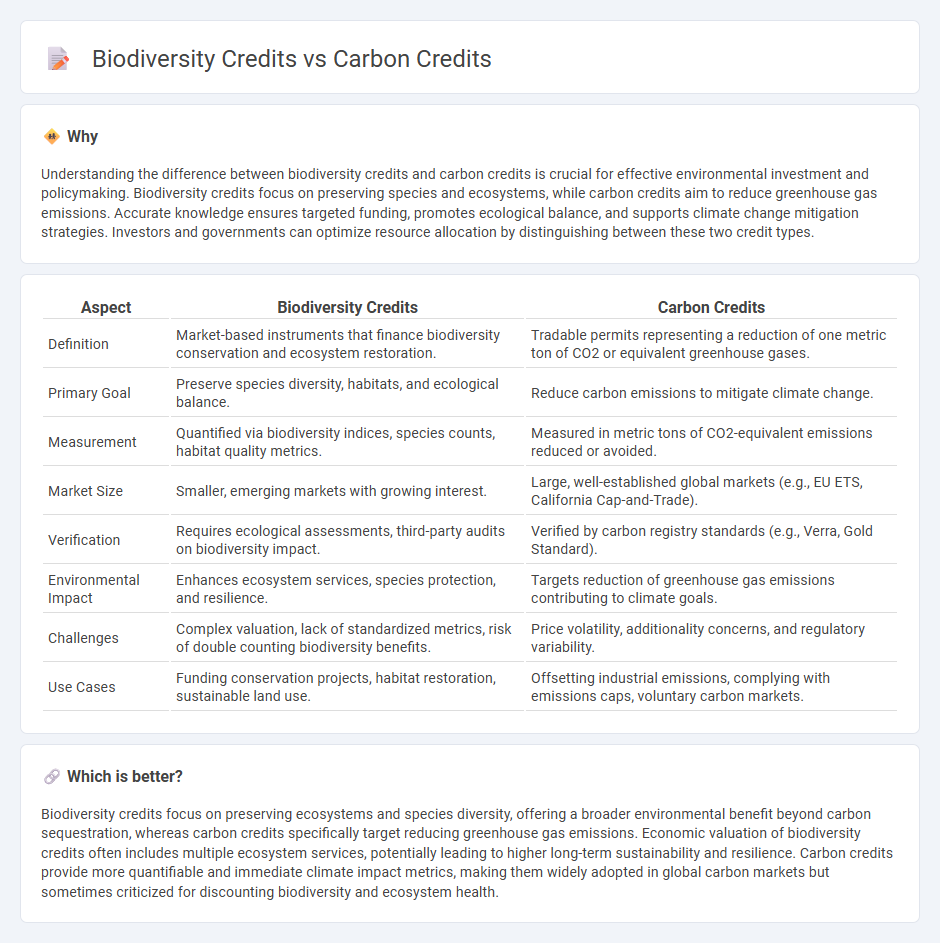
Biodiversity credits and carbon credits represent innovative market-based mechanisms aimed at environmental conservation and climate change mitigation. Biodiversity credits focus on quantifying and trading the preservation of ecosystems and species, promoting habitat protection and restoration, while carbon credits primarily target the reduction of greenhouse gas emissions by allowing entities to offset their carbon footprint. Explore the dynamics and economic implications of these credits to understand their roles in sustainable development.
Why it is important
Understanding the difference between biodiversity credits and carbon credits is crucial for effective environmental investment and policymaking. Biodiversity credits focus on preserving species and ecosystems, while carbon credits aim to reduce greenhouse gas emissions. Accurate knowledge ensures targeted funding, promotes ecological balance, and supports climate change mitigation strategies. Investors and governments can optimize resource allocation by distinguishing between these two credit types.
Comparison Table
| Aspect | Biodiversity Credits | Carbon Credits |
|---|---|---|
| Definition | Market-based instruments that finance biodiversity conservation and ecosystem restoration. | Tradable permits representing a reduction of one metric ton of CO2 or equivalent greenhouse gases. |
| Primary Goal | Preserve species diversity, habitats, and ecological balance. | Reduce carbon emissions to mitigate climate change. |
| Measurement | Quantified via biodiversity indices, species counts, habitat quality metrics. | Measured in metric tons of CO2-equivalent emissions reduced or avoided. |
| Market Size | Smaller, emerging markets with growing interest. | Large, well-established global markets (e.g., EU ETS, California Cap-and-Trade). |
| Verification | Requires ecological assessments, third-party audits on biodiversity impact. | Verified by carbon registry standards (e.g., Verra, Gold Standard). |
| Environmental Impact | Enhances ecosystem services, species protection, and resilience. | Targets reduction of greenhouse gas emissions contributing to climate goals. |
| Challenges | Complex valuation, lack of standardized metrics, risk of double counting biodiversity benefits. | Price volatility, additionality concerns, and regulatory variability. |
| Use Cases | Funding conservation projects, habitat restoration, sustainable land use. | Offsetting industrial emissions, complying with emissions caps, voluntary carbon markets. |
Which is better?
Biodiversity credits focus on preserving ecosystems and species diversity, offering a broader environmental benefit beyond carbon sequestration, whereas carbon credits specifically target reducing greenhouse gas emissions. Economic valuation of biodiversity credits often includes multiple ecosystem services, potentially leading to higher long-term sustainability and resilience. Carbon credits provide more quantifiable and immediate climate impact metrics, making them widely adopted in global carbon markets but sometimes criticized for discounting biodiversity and ecosystem health.
Connection
Biodiversity credits and carbon credits are interconnected financial instruments that monetize environmental benefits, promoting ecosystem conservation and climate change mitigation. Biodiversity credits quantify and reward the preservation of species and habitats, while carbon credits focus on reducing greenhouse gas emissions through carbon sequestration or avoidance. Both markets drive sustainable development by incentivizing landowners and companies to engage in practices that enhance natural capital and reduce environmental impact.
Key Terms
Emissions Reduction
Carbon credits quantify and trade reductions in greenhouse gas emissions, primarily targeting carbon dioxide to mitigate climate change. Biodiversity credits focus on preserving or restoring ecosystems and species diversity, indirectly contributing to emissions reduction by enhancing natural carbon sinks. Explore the distinct mechanisms and benefits of both systems to understand their roles in sustainable environmental strategies.
Ecosystem Services
Carbon credits primarily target the reduction of greenhouse gas emissions by quantifying and trading carbon sequestration, while biodiversity credits focus on preserving and enhancing species diversity and ecosystem functions. Ecosystem services such as pollination, water purification, and soil fertility are central to biodiversity credits, ensuring the long-term health and resilience of natural habitats. Explore how integrating these credit systems can optimize conservation efforts and promote sustainable ecosystem management.
Market Mechanism
Carbon credits function as tradable certificates representing the reduction of one metric ton of CO2 emissions, primarily facilitating compliance with carbon reduction regulations and voluntary offset markets. Biodiversity credits, in contrast, quantify and trade the conservation or restoration of ecosystems, emphasizing species protection, habitat preservation, and enhanced ecosystem services through market-driven mechanisms. Explore the evolving frameworks and market trends shaping the future of carbon and biodiversity credit systems to understand their impact and opportunities.
Source and External Links
Carbon Credits Explained | Climate Impact Partners - Carbon credits represent one tonne of CO2 or equivalent greenhouse gases avoided or removed, allowing companies to offset unavoided emissions by funding verified decarbonization projects.
Ask the experts: Carbon credits 101 - Carbon credits function in cap-and-trade systems or as offsets, enabling entities to meet emissions caps or voluntarily counteract their carbon footprint by supporting emissions reduction projects.
Carbon offsets and credits - Wikipedia - A carbon credit is a tradable certificate representing one metric tonne of CO2 equivalent emission reduction, serving as a form of carbon pricing to compensate for emitted greenhouse gases.
 dowidth.com
dowidth.com